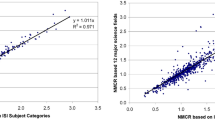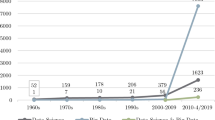Abstract
Bibliographic databases are frequently used and analysed for the purpose of assessing the capacity and performance of individual researchers or entire research systems. Many of the advantages and disadvantages are the subject of continued discussion in the relevant literature, although only rarely with respect to the regional dimension of scientific publication activity. The importance of the regional dimension of science is reflected in many theoretical concepts, ranging from innovation system theories to territorial cluster concepts and learning regions. This article makes use of the extensive information found in bibliographic data and assesses the reliability of this information as a proxy indicator for the spatial dimension of scientific collaboration in emerging economies. This is undertaken using the example of the emerging field of biotechnology in China from 2000 onwards. Two data sets have been prepared: (1) the frequently used ISI Web of Knowledge database (SCI-Expanded) and (2) the domestic Chinese Chongqing VIP database. Both data sources were analysed using a variety of bibliometric and network scientific methods. The structural and topological similarity of networks, built from co-authorship data, is apparent between the two databases. At an abstract level, general network forces are present, resulting in similar network sizes, clustering, or assortativity. However, introducing additional complexity through regional subdivision reveals many differences between the two data sources that must be accounted for in the analytic design of future scientometric research in dynamic spaces.







Similar content being viewed by others
Notes
The exact search string was “CU = China AND (TS = ((Cell OR Enzyme OR Applied) SAME Bio*) OR TS = Bionic)”.
References
Anderson, B. S., Butts, C., & Carley, K. (1999). The interaction of size and density with graph-level indices. Social Networks, 21(3), 239–267.
Barabási, A.-L., & Albert, R. (1999). Emergence of scaling in random networks. Science, 286(5439), 509–512.
Basu, A. (2010). Does a country’s scientific ‘productivity depend’ critically on the number of country journals indexed? Scientometrics, 82(3), 507–516.
Cooke, P., Heidenreich, M., & Braczyk, H.-J. (Eds.). (2004). Regional innovation systems. London: Routledge.
Deng, M., & He, T. W. (2004). Science-metrics analysis of collaborative characters of basic research of biochemistry and molecular biology in China. Science of Science and Management of S&T, 25(9), 10–12 (in Chinese).
Dolfsma, W., & Soete, L. (Eds.). (2006). Understanding the dynamics of a knowledge economy. Cheltenham: Edward Elgar.
Etzkowitz, H., & Leydesdorff, L. (2000). The dynamics of innovation: From National Systems and “mode 2” to a triple helix of university–industry–government relations. Research Policy, 29(2), 109–124.
Frenken, K., Hardeman, S., & Hoekman, J. (2009). Spatial scientometrics: Towards a cumulative research program. Journal of Informetrics, 3(3), 222–232.
Gao, X., & Guan, J. (2009). A scale-independent analysis of the performance of the Chinese innovation system. Journal of Informetrics, 3(4), 321–331.
Gu, J. M. (2009). Analysis of the policy on the professional development of academic staff: A case study of Zhejiang University. China Higher Education Research, 5, 52–54.
Guan, J., & Gao, X. (2008). Comparison and evaluation of Chinese research performance in the field of bioinformatics. Scientometrics, 75(2), 357–379.
Guan, J., & He, Y. (2005). Comparison and evaluation of domestic and international outputs in Information Science & Technology Research of China. Scientometrics, 65(2), 215–244.
Guan, J. C., & Ma, N. (2007). China’s emerging presence in nanoscience and nanotechnology. A comparative bibliometric study of several nanoscience ‘giants’. Research Policy, 36(6), 880–886.
Haas, P. M. (1992). Introduction: Epistemic communities and international policy coordination. International Organization, 46(1), 1–35.
Hennemann, S., Rybski, D., & Liefner, I. (2010). The myth of global science. Paper presented at the ERSA conference 2010, Jönköping, Sweden.
Jin, B. H., & Wang, B. (1999). Chinese science citation database: Its construction and application. Scientometrics, 45(2), 325–332.
Jonkers, K. (2009). Emerging ties: Factors underlying China‘s co-publication patterns with Western European and North American research systems in three molecular life science subfields. Scientometrics, 80(3), 775–795.
Katz, J. S., & Martin, B. R. (1997). What is research collaboration? Research Policy, 26(1), 1–18.
Laudel, G. (2002). What do we measure by co-authorships? Research Evaluation, 11(1), 3–15.
Li, L., & Yang, G. (2004). Comparative study of two Chinese full-text journal databases. Modern Information, 5, 2–7 (in Chinese).
Liang, L. (2003). Evaluating China’s research performance: How do SCI and Chinese indexes compare? Interdisciplinary Science Reviews, 28(1), 38–43.
Liang, L., & Zhu, L. (2002). Major factors affecting China’s inter-regional research collaboration: Regional scientific productivity and geographical proximity. Scientometrics, 55(2), 287–316.
Liefner, I., & Hennemann, S. (2011). Structural holes and new dimensions of distance: The spatial configuration of the Scientific Knowledge Network of China‘s Optical Technology Sector. Environment and Planning A. doi:10.1068/a43100.
Lin, M.-W., & Zhang, J. (2007). Language trends in nanoscience and technology: The case of Chinese-language publications. Scientometrics, 70(3), 555–564.
Lundberg, J., Tomson, G., Lundkvist, I., Skor, J., & Brommels, M. (2006). Collaboration uncovered: Exploring the adequacy of measuring university–industry collaboration through co-authorship and funding. Scientometrics, 69(3), 575–589.
Lundvall, B.-Å. (Ed.). (1992). National systems of innovation: Towards a theory of innovation and interactive learning. London: Pinter.
Ma, N., & Guan, J. C. (2005). An exploratory study on collaboration profiles of Chinese publications in molecular biology. Scientometrics, 65(3), 343–355.
Maslov, S., & Sneppen, K. (2002). Specificity and stability in topology of protein networks. Science, 296(5569), 910–913.
Meho, L. I., & Yang, K. (2007). Impact of data sources on citation counts and rankings of LIS faculty: Web of science versus Scopus and Google scholar. Journal of the American Society for Information Science and Technology, 58(13), 2105–2125.
Mély, B., El Kader, A., Dudognon, G., & Okubo, Y. (1998). Scientific publications of China in 1994: Evolution of revolution? Scientometrics, 42(1), 3–16.
Moed, H. F. (2002). Measuring China’s research performance using the Science Citation Index. Scientometrics, 53(3), 281–296.
Newman, M. E. J., & Park, J. (2003). Why social networks are different from other types of networks. Physical Review E, 68(3), 036122.
Norris, M., & Oppenheim, C. (2007). Comparing alternatives to the Web of Science for coverage of the social sciences’ literature. Journal of Informetrics, 1(2), 161–169.
Otte, E., & Rousseau, R. (2002). Social network analysis: A powerful strategy, also for the information sciences. Journal of Information Science, 28(6), 441–453.
Ponten, S. C., Daffertshofer, A., Hillebrand, A., & Stam, C. J. (2010). The relationship between structural and functional connectivity: Graph theoretical analysis of an EEG neural mass model. NeuroImage, 52, 985–994.
Porter, M. E. (1990). The competitive advantage of nations. New York: The Free Press.
Ren, S., & Rousseau, R. (2002). International visibility of Chinese scientific journals. Scientometrics, 53(3), 389–405.
Royle, J., Coles, L., Williams, D., & Evans, P. (2007). Publishing in international journals—An examination of trends in Chinese co-authorship. Scientometrics, 71(1), 59–86.
van Wijk, B. C. M., Stam, C. J., & Daffertshofer, A. (2010). Comparing brain networks of different size and connectivity density using graph theory. PLoS ONE, 5(10), e13701.
Wan, J.-k., Hua, P.-h., Rousseau, R., & Sun, X.-k. (2010). The journal download immediacy index (DII): experiences using a Chinese full-text database. Scientometrics, 82(3), 555–566.
Wang, S., Wang, H., & Weldon, P. R. (2007). Bibliometric analysis of English-language academic journals of China and their internationalization. Scientometrics, 73(3), 331–343.
Wang, Y., Wu, Y. S., Pan, Y. T., Ma, Z., & Rousseau, R. (2005). Scientific collaboration in China as reflected in co-authorship. Scientometrics, 62(2), 183–198.
Wasserman, S., & Faust, K. (1994). Social network analysis: Methods and applications. Cambridge: Cambridge University Press.
Watts, D. J., & Strogatz, S. H. (1998). Collective dynamics of ‘small-world’ networks. Nature, 393, 440–442.
Weisberg, M., & Muldoon, R. (2009). Epistemic landscapes and the division of cognitive labor. Philosophy of Science, 76(4), 225–252.
Wu, Y., Pan, Y., Zhang, Y., Ma, Z., Pang, J., Guo, H., et al. (2004). China Scientific and Technical Papers and Citations (CSTPC): History, impact and outlook. Scientometrics, 60(3), 385–397.
Zhang, F., Cooke, P., & Wu, F. (2010). State-sponsored research and development: A case study of China’s Biotechnology. Regional Studies (online first).
Zhang, H., & Guo, H. (1997). Scientific research collaboration in China. Scientometrics, 38(2), 309–319.
Zhao, J., & Guo, J. (2002). The restructuring of China’s higher education: An experience for market economy and knowledge economy. Educational Philosophy and Theory, 34(2), 207–222.
Zhou, P., & Leydesdorff, L. (2006). The emergence of China as a leading nation in science. Research Policy, 35(1), 83–104.
Zhou, P., & Leydesdorff, L. (2007). A comparison between the china scientific and technical papers and citations database and the Science Citation Index in terms of Journal Hierarchies and Interjournal Citation Relations. Journal of the American Society for Information Science and Technology, 58(2), 223–236.
Zhou, P., Thijs, B., & Glänzel, W. (2009). Regional analysis on Chinese scientific output. Scientometrics, 81(3), 839–857.
Acknowledgments
Wang Tao appreciates a travel grant from the German Academic Exchange Service (DAAD). This research was supported by the National Science Foundation of China (NSFC) under grant #40971069. The authors thank two anonymous reviewers for their helpful comments.
Author information
Authors and Affiliations
Corresponding author
Rights and permissions
About this article
Cite this article
Hennemann, S., Wang, T. & Liefner, I. Measuring regional science networks in China: a comparison of international and domestic bibliographic data sources. Scientometrics 88, 535–554 (2011). https://doi.org/10.1007/s11192-011-0410-1
Received:
Published:
Issue Date:
DOI: https://doi.org/10.1007/s11192-011-0410-1




